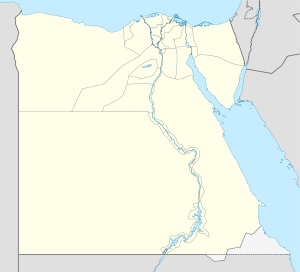- Nekhen
-
Coordinates: 25°5′50″N 32°46′46″E / 25.09722°N 32.77944°E
Nekhen
HierakonpolisLocation in Egypt Coordinates: 25°5′50″N 32°46′46″E / 25.09722°N 32.77944°E Country  Egypt
EgyptTime zone EST (UTC+2) - Summer (DST) +3 (UTC)
or
![O49 [niwt] niwt](/w/extensions/wikihiero/img/hiero_O49.png)

![N35 [n] n](/w/extensions/wikihiero/img/hiero_N35.png)
![O49 [niwt] niwt](/w/extensions/wikihiero/img/hiero_O49.png)
Nekhen
in hieroglyphs- Hieraconpolis redirects here; for the ancient fortress in Egypt called Hieracon, see Hieracon
Nekhen (Greek: Ἱεράκων πόλις 'city of hawks', Strabo xvii. p. 817, transliterated as Hierakonpolis, Hieraconpolis, or Hieracompolis; Arabic: الكوم الأحمر Al-Kom Al-Aħmar) was the religious and political capital of Upper Egypt at the end of the Predynastic period (c. 3200–3100 BC) and probably, also during the Early Dynastic Period (c. 3100–2686 BC). Some authors suggest occupation dates that should begin thousands of years earlier.
Contents
Horus cult center
Nekhen was the center of the cult of a hawk deity Horus of Nekhen, which raised in this city one of the most ancient temples in Egypt, and it retained its importance as the cult center of this divine patron of the kings long after it had otherwise declined.
The original settlement on the Nekhen site dates from the culture known as Naqada I of 4400 BC or the late Badarian culture that may date from 5000 BC. At its height from about 3400 BC Nekhen had at least 5,000 and possibly as many as 10,000 inhabitants.
The ruins of the city originally were excavated toward the end of the nineteenth century by the English archaeologists James E. Quibell and F. W. Green. In the "principal deposit" of the temple of Nekhen they found important ceremonial Protodynastic artifacts such as the Narmer Palette and the famous macehead bearing the name of King Scorpion. More recently, the concession was excavated further by a multinational team of archaeologists, Egyptologists, geologists, and members of other sciences, which was coordinated by Michael Hoffman until his death in 1990, then by Barbara Adams of University College London and Dr. Renee Friedman representing the University of California, Berkeley and the British Museum until Barbara Adams's death in 2001, and by Renee Friedman thereafter.
"Fort"
The structure at Nekhen with the misnomer, "fort", [1] is a massive mud-brick enclosure, built by King Khasekhemwy of the Second Dynasty. It appears to be similar in structure and purpose as the 'forts' constructed at Abydos, and has no apparent military function. The true function of these structures is unknown, but they seem to be related to the rituals of kingship and the culture. [2]
The ritual structure was built on a Predynastic cemetery. The excavations there, as well as the work of later brick robbers, have seriously undermined the walls and led to the near collapse of the structure. For two years, during 2005 and 2006, the team led by Renee Friedman was attempting to stabilize the existing structure and support the endangered areas of the structure with new mud-bricks. [3]
Oldest known Egyptian painted tomb
Other discoveries at Nekhen include the oldest tomb with painted decoration along its plaster walls that contains presumed religious scenes and images that include figures that will appear in Egyptian culture for three thousand years—a funerary cortege of barques, possibly a goddess standing between two upright lionesses, a wheel of various horned quadrupeds, several examples of a staff that became associated with the deity of the earliest cattle culture and one being help up by a heavy-breasted goddess, asses or zebras, ibex, ostriches, lionesses, impala, gazelles, and cattle. It is thought to have been decorated in the Predynastic period of southern Egypt.
Oldest known zoo
The oldest known zoological collection was revealed during excavations at Hierakonpolis in 2009 of a menagerie that dates to ca. 3500 BC. The exotic animals included hippos, hartebeest, elephants, baboons and wildcats.[4]
Later activity
There are some later tombs at Nekhen, dating to the Middle Kingdom, Second Intermediate Period and New Kingdom. In the tomb of Horemkhaef was found a biographical inscription reporting Horemkhaef's journey to the capital of Egypt.
References
External links
Categories:- Archaeological sites in Egypt
- Ancient Greek sites in Egypt
- Cities in Ancient Egypt
- Former populated places in Egypt
Wikimedia Foundation. 2010.

